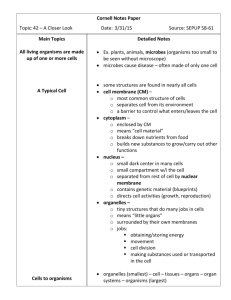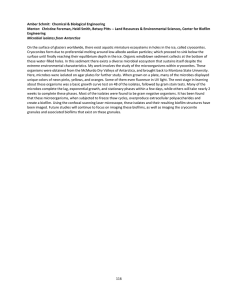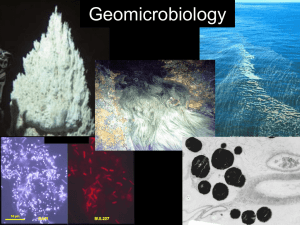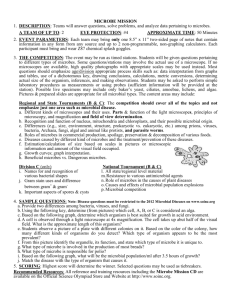20.106J – Systems Microbiology Lecture 5 Prof. DeLong
advertisement
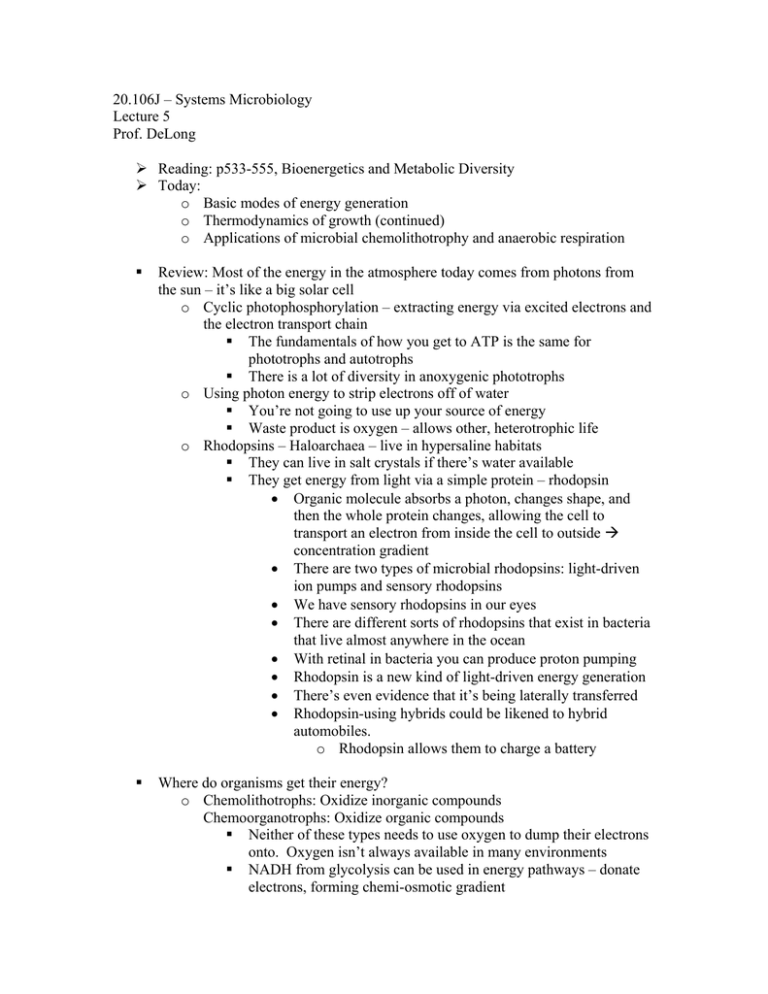
20.106J – Systems Microbiology Lecture 5 Prof. DeLong ¾ Reading: p533-555, Bioenergetics and Metabolic Diversity ¾ Today: o Basic modes of energy generation o Thermodynamics of growth (continued) o Applications of microbial chemolithotrophy and anaerobic respiration Review: Most of the energy in the atmosphere today comes from photons from the sun – it’s like a big solar cell o Cyclic photophosphorylation – extracting energy via excited electrons and the electron transport chain The fundamentals of how you get to ATP is the same for phototrophs and autotrophs There is a lot of diversity in anoxygenic phototrophs o Using photon energy to strip electrons off of water You’re not going to use up your source of energy Waste product is oxygen – allows other, heterotrophic life o Rhodopsins – Haloarchaea – live in hypersaline habitats They can live in salt crystals if there’s water available They get energy from light via a simple protein – rhodopsin • Organic molecule absorbs a photon, changes shape, and then the whole protein changes, allowing the cell to transport an electron from inside the cell to outside Æ concentration gradient • There are two types of microbial rhodopsins: light-driven ion pumps and sensory rhodopsins • We have sensory rhodopsins in our eyes • There are different sorts of rhodopsins that exist in bacteria that live almost anywhere in the ocean • With retinal in bacteria you can produce proton pumping • Rhodopsin is a new kind of light-driven energy generation • There’s even evidence that it’s being laterally transferred • Rhodopsin-using hybrids could be likened to hybrid automobiles. o Rhodopsin allows them to charge a battery Where do organisms get their energy? o Chemolithotrophs: Oxidize inorganic compounds Chemoorganotrophs: Oxidize organic compounds Neither of these types needs to use oxygen to dump their electrons onto. Oxygen isn’t always available in many environments NADH from glycolysis can be used in energy pathways – donate electrons, forming chemi-osmotic gradient Organisms that don’t use oxygen have similar electron transport chains, they just don’t use oxygen as the final electron acceptor. Often, they use iron, sulfate, or nitrate. Chemolithotrophs are the same story These kinds off microbes are important, for example, in aquariums. You use them to keep the fish from dying of ammonium poisoning from their own waste. Applications o The nitrogen from fertilizers gets into ground waters Æ Anammox: “Anaerobic Ammonium Oxidation.” This is a pretty new method. Broda predicted (solely based on the thermodynamics) that microbes that do this must exist: NH 2 + NO2− ⎯⎯ → N 2 + 2 H 2O If a favorable niche exists, then something will evolve to fill it The microbes were discovered ten years ago These microbes produce hydrazine, which is very reactive (rocket fuel) • The organisms contain this reactive hydrazine within special pockets These organisms are not easy to grow, but with the right conditions you can do it These organisms also do carbon dioxide removal as well as nitrogen removal People have built big plants that do this very efficiently now, particularly in the Netherlands Denitrifiers are another way you can remove nitrogen o Picture: Geobacter growing on iron hydroxides. They grow on a solid, not in a solution o Microbial redox interactions with uranium: an environmental perspective o If you look at a sediment, you can predict where the different types of reduction are going to occur on each level. This has to do with energetics – it explains the order (ΔGo) o Microbial bioremediation of uranium Uranium (VI) is water soluble, radioactive, and toxic, and it can end up in ground water (produced by energy production and nuclear bombs) These microbes convert uranium (VI) to uranium (IV), which is insoluble, so it won’t end up in the ground water. All you need to do is add acetates and the microbes (which are already everywhere) will convert the uranium (VI), which then precipitates and falls out of the moving water. o Geobacter can use electrodes as an electron acceptor Thus allowing us to harvest power from aquatic sediments and other sources of waste organics Microbial fuel cell, powered by residual organics These aren’t very powerful, but they can run small systems How do these organisms dump electrons onto a solid? • It’s not terribly well understood • It involves the pili – they transmit electrons o Deep-sea methane hydrates are buried in sediments off of continental margins worldwide They hold huge amounts of carbon in them – there’s more carbon in these deposits than there is in petroleum desposits ZX CO2 + 4 H 2 Methane can burn without oxygen: CH 4 + 2 H 2O YZZ • However, methanogens drive the reaction in reverse. It doesn’t really go forward. Instead, we can use this reaction: CH 4 + SO42− ⎯⎯ → HCO3− + HS − + H 2O There’s no individual microbe known that can do this, but they can do it in teams. Microbiologically: CH 4 + SO42− ⎯⎯ → HCO3− + HS − + H 2O : ΔGo′ = −25 kJ mol • This is a very small amount of energy per mole. Difficult, but it does work. (It’s believed that -20kJ/mol would be at the limit of feasibility.) • Two different types of microbes work together symbiotically so that this total reaction runs. This can control methane on a global scale o All of these applications can be figured out largely from basic principles, so they’re very powerful.
